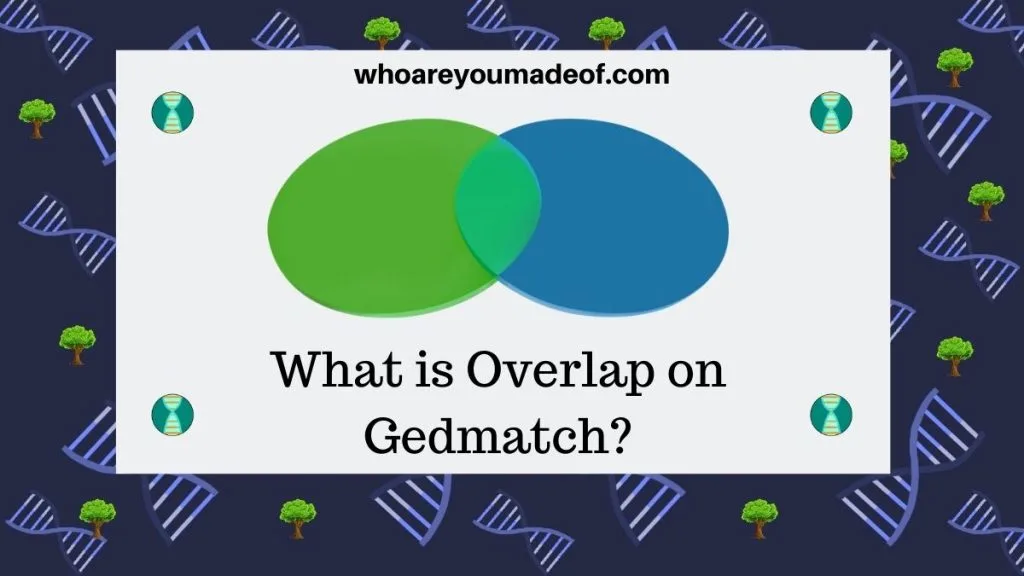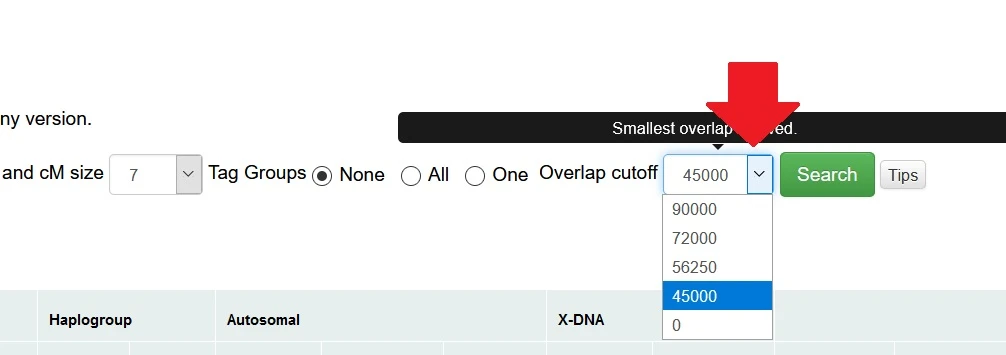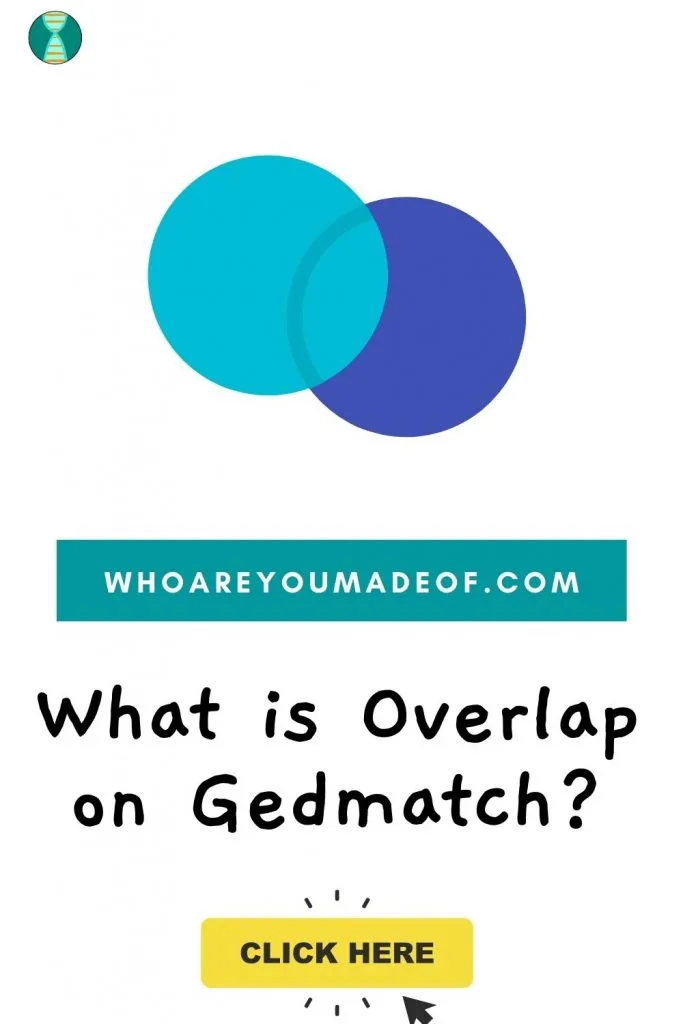Do you want to know what overlap means on Gedmatch results? In this post, learn all about overlap, including low overlap and overlap cutoff.
Understanding Gedmatch tools can seem complicated at first glance, especially if you are new to the Gedmatch site. However, if you learn about each of the terms and concepts, you will find that understanding all of the DNA details is not difficult at all.

The word “overlap” appears all over Gedmatch tools and results. For example, you might have noticed that there is an entire column for overlap in the One-to-Many results.
What do all of these large numbers mean? Is higher better? What does it mean if there is low overlap?
Let’s find out.
What does overlap mean on Gedmatch results?
Every DNA testing company tests hundreds of thousands of positions in your DNA, called SNPs. SNP is short for single nucleotide polymorphism.
These SNPs (pronounced “snip”), sometimes also referred to as “copying errors”, are the locations in our DNA where we (humans) are different. Companies choose specific SNPS to test because they are known locations where SNPs vary from person to person.
Some of the SNPs tested by the various testing companies will overlap with those positions tested by others. This is one reason why we see slightly different numbers for shared centimorgans between DNA matches that have tested with multiple companies.
All of the major DNA testing companies test approximately 700,000 SNPS of the 4-5 million SNPs that the human genome might contain. According to one chart, the exact number of SNPs tested between companies currently ranges from about 612,000 to 702,000.
The exact number of your SNPs that were tested will depend on the company that you chose to test with and the version of test they used. As technology improves, testing more SNPs becomes more feasible.
The Gedmatch tools can only analyze regions with testing “overlap”. The number of SNPs reported in the overlap column is the total number of SNPs within the region where the shared DNA is found, though it doesn’t mean that every single SNP is identical.
We like overlap. The more overlap, the higher quality the DNA match.
We will also notice that higher overlap can coincide with a higher total amount of shared DNA. In addition, people who tested with the same DNA testing company will find higher overlap of SNPs.
How high can overlap be? Pretty high.
For example, take a look at the image below. It’s from my Gedmatch One-to-Many results.

The top match in my Gedmatch One-to-Many results is my mother. We share more than 3500 cMs and the overlap is more than 320,000 SNPs.
We would expect a very close match to share lots of cMs and have a lot of overlap. It’s important to note that we can see high overlap in more distant matches, however.
The other match that I highlighted in the image above is a more distant cousin. We both tested with Ancestry DNA (important, since SNP locations are largely the same), and share only 30.5 cMs with an overlap of more than 300,000.
What does “overlap cutoff” mean on One-to-Many tool?
When we begin using the One-to-Many tool on Gedmatch, we see that we have several options, including the option to adjust the overlap cutoff. Adjusting the default settings for the tool will provide different results.
The default cutoff number for SNPs is 45,000. You can choose 56250, 72000, and 90000.

If you choose a higher number of SNPs for the overlap cutoff, you will receive a smaller number of matches. The quality of the match (i.e. the probability that you are descended from a common ancestor in the genealogical time frame) will conceivably be higher, however.
What does it mean when the overlap column is pink on Gedmatch?
When the cell in the overlap column on Gedmatch is pink, it means that there is “low overlap” shared between you and your DNA match on the site. This simply means that there is a low number of SNPs in the region where you and your match share identical DNA.
Low overlap between DNA matches on Gedmatch can often signal a low quality match – meaning that the shared DNA reported may not be significant. Do not automatically ignore low overlap matches, however.
For example, if you tested with Ancestry DNA and your match tested with 23andMe, you might notice that the overlap column is either pink or has a lower number in it. These are both high quality tests and as long as the shared DNA is significant, you could research the connection.

The matches shown in the image above have low overlap. I noticed that they tested on 23andMe, so I looked them up on my DNA match list on 23andMe (the test I uploaded to Gedmatch was from Ancestry DNA).
These matches were on 23andMe, though the number of shared centimorgans was slightly different than what showed up on Gedmatch. The point is that you shouldn’t always ignore low overlap matches.

Conclusion
Did this article help you understand more about “overlap” on Gedmatch? I hope you learned enough about it to be able to understand your results more completely.
If you have any questions about something that you read in this post, or if you would like to add your own insight about overlap, I would love for you to join us in the discussion below.
Thanks for stopping by!


Karen Langford
Wednesday 31st of May 2023
Just came across this website by accident. Wow what a wealth of information and in everyday language. I just learned from this posting about downloading my enticity on 23andMe. Which I just did. I don't my paternal father so I'm hoping I can figure out somethings. But, in looking at it looks like they copy 1 and copy 2 are so similar except for jewish. I know my maternal is Irish, since my mother was a Gallagher, Also, I always wondered about the overlap on Gedmatch, now I understand it. Thank you
Mercedes
Saturday 3rd of June 2023
Thank you so much, Karen! I really appreciate your kind words.
Sheila Bousson
Sunday 14th of November 2021
I thought when I retired I would have as much time as was needed to delve into the percentages of genetic matches. I felt it was too difficult to learn while my mind had to think about the mundane daily life of work and home life.
I became obsessed with creating a genealogy tree 13 years ago with the birth of my first grandchild. I felt that I needed to dedicate myself to the pull of occasional overnighters on the computer gathering facts. Endless hours spent when getting my son, daughter, and son-in-law their DAR and SAR while I was working, it was not a great mix.
However! I did check my matches (but not daily) send a few Hello Cousin notes, then when I find myself back there am: 1) not disappointed that no one has messaged back or 2) throughly surprised that some-one did!
I received a true gift one day from a 3rd cousin of my fathers line. It was a portrait of my GGGrandparents, with my Grandfather in his late teens. Out of nowhere! Like a surprise from beyond!
Photos of my father with his "promise ring" sweetheart. Not my mother!
I figured out a genetic conundrum with a male cousin in Vietnam siring a baby girl who was brought up in an orphanage just outside Saigon. (I told my brother to contact him to let him know, so it would not come as such a surprise later when they found out from the Grandson he didn't know he had).
I am in touch now with several cousins whom I have never met. We share photos of the family.
All of this from just a few messages sent out, not expecting them to be answered! Maybe that's enough for me? Maybe I don't need to delve deeper? Time will tell.
Sheila
Herbert Holeman
Sunday 7th of November 2021
Thank you Mercedes for an interesting article on GEDmatch overlap, but what conclusions can be made from such data? Is there something like a "cutoff" or whatever related to IBD? Herbert
Mike Carroll
Tuesday 10th of November 2020
Male A (tested Ancestry) and matches Female B (tested 23& me) at 751 cM's. On gedmatch the cell is pink (low Overlap). Normally the cM's indicate 1st cousin but paper genealogy tells me 2C1R.
Female A sister of Male A also tested Ancestry and matches Female B at 347cM's. cM's indicate 1C1R or half 1C but paper says 2C1R same as her brother. How much confidence do I have that the match accurately depicts the relationship?